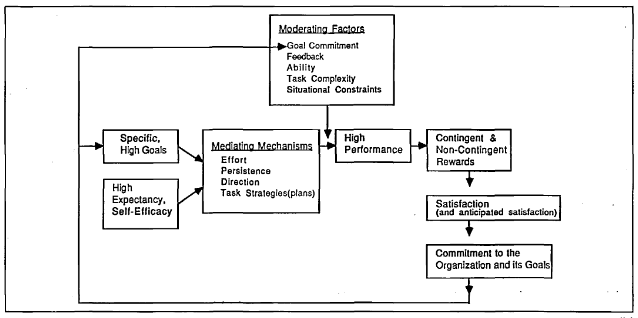It’s always worthy to strengthen one’s mental model about we as humans work best. So let’s read WORK MOTIVATION AND SATISFACTION: Light at the End of the Tunnel and see if we see the same light.

The paper first names its intellectual ancestors, other psychological theories it is basing its ideas on. I think it’s worth to quickly grasp their core ideas so we can see whether we want to explore any of them further. First, a list:
- Goal Setting
- Expectance
- Social-Cognitive
- Attribution
- Job Characteristics
- Equity
- Turnover-Commitment
Their theory then they call High Performance Cycle, but one thing after the other.
Goal Setting Theory
The idea that behavior is defined by consciously setting goals and then trying to achieve them. It highlights the importance of specific goals, commitment, good feedback and the possibility to actually reach the goal.
Expectancy Theory and Social Cognitive Theory
In contrast, proponents of this theory see the following three aspects as the main predictors of performance:
- Expectancy, as in “expecting some kind of reward”
- Instrumentality, which is believing that that reward can indeed be reached by performing
- Valance, which means considering the reward valuable (which I find a bit redundant, because rewards are always subjective, right?)
Self-Efficacy is our social-cognitive part here, and is basically an extension of expectancy and instrumentality: It’s both the consideration whether the reward is to be expected, but also the calculation how able I am to get it. And it goes even further, including stuff like “how well can I handle the situation as a whole”.
Rewards: Attribution, Equity, Job Characteristics
All the theories mentioned above relate to rewards, so let’s group them.
Job Characteristics Theory basically says that work is satisfying when it has the following five characteristics:
- Personal significance
- Variety
- Feedback
- Responsibility/autonomy
- Identity (an identifiable, whole chunk of work)
Sounds reasonable enough, although I should probably read up on how well this model is supported empirically.
Equity Theory is quite interesting, it argues that people (individually and subjectively) judge whether rewards are being dished out fairly in proportion to the work someone has done. After that, they become either satisfied or dissatisfied with the whole thing depending if they think it’s “fair”. Interesting way to think about it!
Attribution Theory kinda ties into this; it means people judging whether success was created by themselves of external factors (e.g. luck). That of course matters for judging what rewards are fair, but also self-attributed success is just generally more satisfying.
Turnover-Commitment
I am still not very sure what Turnover-Commitment is; it is just mentioned in the quite briefly and turns up in a cited paper which I am too lazy to read. The core question is, I think, under what circumstances people stay in or leave an organization - satisfaction seems to matter, but is not the only factor.
The model
The authors then combine their interpretations of all these theories and the research they produced to a single unifying theory.
Alright then, let’s check out the model they made:

“The high performance cycle”
To be honest, I don’t find the structure of the diagram particularly enlightening. While the authors do claim that this is a theoretically supported model, I am not seeing how the cited research specifically supports this particular layout and no other.
Also the rest of the paper is mostly spent with complaining about undereducated college graduates, which is entertaining but does not really help understanding things like: Why is it High Performance? Because after all, if the Moderating Factors would be such and such, it would indeed be Low Performance, no?
Closing words
What I am taking from the paper however is a plethora of different ideas to think about the whole problem, which as the author say is relevant for both organizational management and personal growth. And it’s not just of academic interest! On the contrary, this paper urges me to ask myself questions like:
- How do I set goals?
- Am I expecting commitment from myself before fulfilling the preconditions?
- What are moderating factors of my performance and how can I mitigate them?
- When am I blocked by a lack of self-efficacy?
- Am rewarding myself fairly?
Important questions! And as hinted, if you are indeed managing other people, they are just as applicable and maybe even more important.
Thanks for reading! This post is part of my series of reading and summarizing papers, mostly relating to UX. I use a casual tone because that’s the most fun to me. That means my interpretation of a given paper may be off. Or incomplete. Or plain wrong. Always think for yourself, and please, don’t cite this in an academic context. Use the original article instead. Cheers!